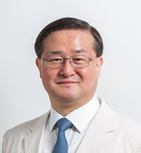교수진 및 연구실 소개SAIHST에는 기초의학, 임상의학, 자연과학, 약학, 공학, 경영대학 등 Health Science와 관련된 다양한 분야를 전공한 교수진이 참여하고 있습니다.
미래의과학을 선도할 역량있는 교수의 참여를 기다립니다.
| 연구실소개 |
 Laboratory of medical genomics for
Laboratory of medical genomics forhereditary peripheral neuropathy /최병옥 교수 E-mail : bochoi@skku.edu Homepage : 참여학과 : 융합의과학과, 의료기기산업학과 인쇄하기 |
|
■ Research objective
I have a broad background in clinical, biological, and stem cell-based tissue engineering in key research areas. I have been researching Charcot-Marie-Tooth disease (CMT), a rare disease, for over 27 years, and the entire process from diagnosis to development of therapeutics. I have collected more than 3,000 DNA samples, as well as their corresponding clinical information, from 1,200 unrelated Korean CMT families; this library represents the biggest CMT patient collection in Asia. The work in my lab focuses on isolating the specific mutations that cause genetically heterogeneous CMT phenotypes using next generation sequencing. We also work extensively on the development and validation of new therapeutic small molecules for this condition. I currently perform functional studies on 10 novel CMT genes. Also, I have made five CMT patient-derived iPSC lines, and have collected more than 200 CMT patient-derived skin fibroblasts or kidney epithelial cells. I have developed and explored new therapeutic options using iPSCs derived from patient's fibroblasts. In addition, my group has developed two kinds of transgenic mouse and four different types of zebrafish, which facilitate the evaluation of new drugs for treating CMT. As a result of these experiences, I have published more than 200 papers and applied for more than 70 patents on CMT alone. ■ Research interests 1)Medical Genomics of hereditary peripheral neuropathy Clinical database and cohort study. I have collected more than 3,000 CMT patient samples. This is the largest CMT sample database in Asia. Recently, I have finished a large scale cohort study of Korean CMT patients, and identified causative mutations in 507 unrelated CMT families using whole exome sequencing (WES). In addition, I have collected electrophysiological data, lower leg MRI, and ultrasonic data from almost all these patients. Through sural nerve biopsy transcriptome studies, I have demonstrated that there are diversities in transcribing RNA, and this data has subsequently been used to inform additional peripheral nerve studies. I am currently working to establish and manage a joint international database for CMT clinical samples through active exchanges with the experts from 30 domestic institutions in Korea, and the other institutions in the United States, Europe and Asia. 2)Identification of ten novel gene mutations causing hereditary peripheral neuropathy The greatest contribution of my career to biomedical science is the identification of 10 novel causative genes for peripheral neuropathy. In addition, I have found 65 novel mutations causing hereditary peripheral neuropathy by WES. I was the first to demonstrate that genes such as MYH14, SBF1, DGAT2, PMP2 contribute to CMT and muscular disease through the study of CMT pathogenesis. I secured mutant genes by cloning, produced cells and animal models using the same, measured intracellular accumulation, lipid metabolism, and enzyme activity of mutant proteins, and studied their pathogenic effect through analysis of motor nerve cells and muscle cells. I secured the foundation data that has enabled more comprehensive study of CMT, including exome sequencing, investigation of causative genes, pathogenesis study, and development of animal model and medicine. 3)Establishment of transgenic mouse for modeling axonal neuropathy I was the first to demonstrate that CMT can be caused by defects in the DGAT2 gene. Additionally, I discovered a distinct phenotype caused by ADSSL1 gene mutations, and conducted the study of this condition using transgenic and knockout zebrafish. I established the production of new mouse models for CMT phenotype analysis by establishing HSP27 and PMP2 mutations in established lines. Furthermore, I established an analysis system, including sthenometry, behavior analysis, gait analysis, electroneurography, MRI, and ultrasonography, to evaluate their phenotypes. I conducted in vivo verification of novel drug candidates using my genetically modified mouse models. I’m currently verifying the therapeutic effectiveness of these compounds in concurrence with pharmaceutical companies as part of a new medicine development project involving drug candidate selection from patient specific drug screening assays incorporating stem cell derived CMT neurons. Additionally, I’m currently seeking various therapeutic approaches for CMT treatment, including a pathogenesis study that involves drug targets, gene therapy, and stem cell therapy, and verifying this concept in vivo using a mouse model. ■ Contact bochoi@skku.edu |

